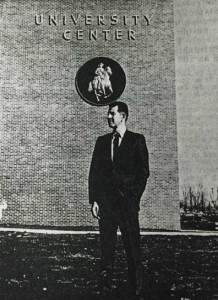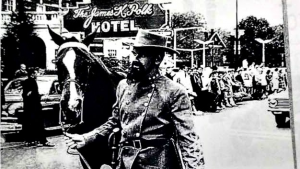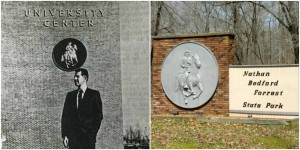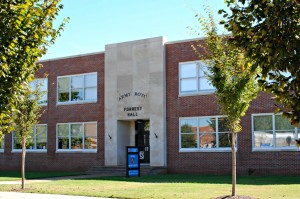A Confederate on campus: The case of MTSU's Forrest Hall
27 October 2015 – Elizabeth Catte

Forrest plaque on the MTSU Keathly University Center. Photo credit: Sidelines campus newspaper, March 1968
Editor’s note: This post continues our series addressing recent debates over Confederate memory and symbolism in the wake of the shooting of nine parishioners at Emanuel African Methodist Episcopal Church in downtown Charleston, South Carolina. Here is the opening post for the series.
On April 4, 1968, an altercation occurred at Middle Tennessee State University’s newly constructed student union building, where a large crowd of students had gathered to await breaking news about the assassination of Martin Luther King, Jr. A white male student cut through the crowd to turn off the news program in a deliberate attempt to provoke other students. This led to a fight, which at least one African American student connected to the unwelcome influence of Confederate symbols on campus. Indeed, an elaborate 600-pound bronze plaque of Confederate General Nathan Bedford Forrest adorned the month-old building where students had gathered to mourn the death of a Civil Rights leader.
An African American student present at the union that night, Sylvester Brooks, later wrote in the campus newspaper Sidelines, “Are you proud of your school’s mascot, General Nathan Bedford Forrest?; the man who founded the Ku Klux Klan; the man who captured Black soldiers fighting for the Union; and the man who marched into Fort Pillow in West Tennessee and murdered 250 Black men, women, and children? . . . Black students have just as much right to feel a part of this campus as anyone else.” Brooks became the most recognizable voice of opposition to MTSU’s Confederate iconography in the late 1960s. The fight he started continues to this day.

MTSU student dressed as Nathan Bedford Forrest at Homecoming, 1962, Midlander Yearbook. Photo credit: Albert Gore Research Center
MTSU, founded in 1911, has no direct connection to Forrest, yet the university used his likeness as a school mascot on athletic paraphernalia from the early 1950s until 1968. Confederate iconography became especially visible during Q.M. Smith’s tenure as president from 1938 to 1958. During Smith’s presidency, MTSU used costumed performers dressed as Forrest at university events, placed his iconography on two buildings, and incorporated his image heavily in university yearbooks, one of which includes a drawing of Forrest holding a Klan hood.

Left: Forrest plaque on the MTSU Keathly University Center, from Sidelines campus newspaper, March 1968. Right: After the plaque was relocated to Nathan Bedford Forrest State Park in 1990. Photo credit: Elizabeth Catte
The Forrest plaque on the student union remained until 1990, when President Sam Ingram ordered the plaque removed months before his retirement. Students returned to campus after winter break in January 1990 to find the plaque gone–donated to Nathan Bedford Forrest State Park–without announcement or discussion. Today, the only Confederate symbol remaining on campus is Forrest Hall, an ROTC building dedicated in 1958.
In 2006, a campus group led by African American students, “Students Against Forrest Hall,” led the effort to rename the building, but the Student Government Association did not share their vision. The Student Government Association first voted to endorse the Students Against Forrest Hall petition but later rescinded their vote after a petition circulated by a white student in the Department of History received more signatures.
The June 2015 murder of nine African American worshippers by a white supremacist in South Carolina, along with a broader national movement to affirm that #BlackLivesMatter, has given a new urgency to old debates. Across the country, students, faculty and staff at public and private universities have called upon their institutions to reckon with the use of Confederate symbols as a way to honor campus diversity and acknowledge the ongoing pain of African Americans caused by the prominent display of these symbols.
At MTSU, in summer 2015, #BlackLivesMatter activists formed a campaign to “Change the Name of Nathan Bedford Forrest Hall” and are raising awareness of anti-black violence committed by Forrest and in Forrest’s name both during and after the Civil War. A campus protest organized by the group in late August was well-attended by students, faculty, alumni, and members of the community.
The Departments of History, Philosophy, and Political Science also have called upon the university to change the name of Forrest Hall. According to the Department of History, the use of Forrest’s image helped to “solidify MTSU’s image as a limited, unambitious institution that served only one race of people.” The Association of Graduate Students in History and the MTSU student chapter of the Society of American Archivists voted to endorse these statements.
In response, University President Dr. Sidney McPhee announced the formation of an advisory committee led by MTSU Civil War scholar Dr. Derek Frisby. The committee will include six representatives drawn from the student body, the faculty, and the community. President McPhee commented that the time was right to “engage our communities” about Forrest Hall and set April 2016 as the committee’s deadline to produce a recommendation. The committee may vote to change the name, keep the name, or keep the name with additional interpretation about Forrest.
It is not yet clear how President McPhee’s closed committee intends to involve the broader university community in this controversial decision. The university has no plans to create a dialogue about this issue through public forums or meetings, and there’s a perceptible silence on campus about Forrest Hall that only organized protest broke. There are also no plans to discuss developments at MTSU within the larger context of campus diversity, as universities like Clemson and University of North Carolina Chapel Hill have done.
It is disappointing that the university has not encouraged a broader dialogue on this issue and the history of these symbols, particularly since retaining the name with additional interpretation is on the table. As public historian Christopher Graham recently argued, “Calling for more content or interpretation is fine,” but, for alternative interpretation projects on Confederate monuments to be successful, we need to ask the right questions about how these new interpretations will be executed for their respective audiences.
As this process unfolds, MTSU public history students are using their skills to document campus and community response. Archival student Sarah Calise, along with her supervisor Donna Baker at the MTSU Albert Gore Research Center, will create a digital archive of the Forrest Hall controversy. Inspired by digital archive projects that document police violence in Ferguson and Cleveland, Calise and Baker want to ensure that an institutional record of this process is preserved to improve the institutional memory of the university. Josh Howard, a PhD Candidate in public history, has also written a narrative history of MTSU’s Forrest mascot.
At MTSU, administrators have used invented Confederate connections as a substitute for the university’s own history and achievements and have put the celebration of a controversial outsider above recognition of those who made the university a better place. This narrow world view has limited the ability of MTSU to be the university that it wants to be: a progressive, student-centered, diverse institution of high quality. It is time to use our own history to honor our buildings and those who study within them.
~ Elizabeth Catte is a PhD Candidate in MTSU’s public history program. She can be reached through her website or on twitter @elizabethcatte.




